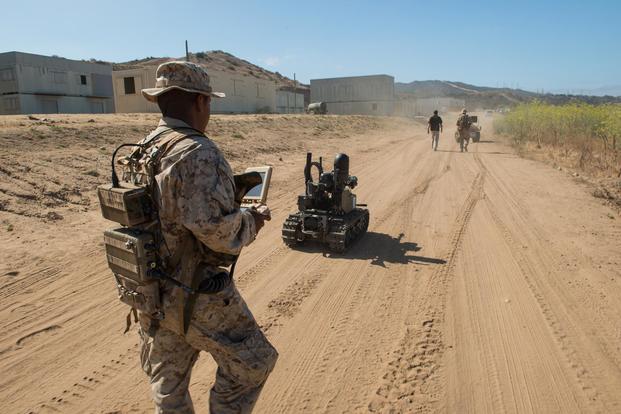The Marine Corps has put out a request to learn whether defense firms can build an unmanned robotic vehicle designed to carry extra ammo, packs, food and water for infantry squads. The effort follows an Army initiative to select an unmanned squad vehicle that can partner with infantrymen to lighten their loads.
"The Marine Corps Rapid Capabilities Office … plans to investigate unmanned vehicle technologies to displace the load currently carried by Infantry Marines at the squad level. Capabilities of interest include ground vehicles with tele-operation capability ... and fully autonomous operation," according to an Oct. 31 request for information posted on the government contracting website FedBizOpps.
While this is not a request for proposal, the intent is to define what it will take to prototype and deliver such a vehicle.
Contractors will need to build and deliver up to three prototype unmanned systems for evaluation by the rapid capabilities office, the draft statement of objectives reads.
The Marine effort "will evaluate systems capable of maneuvering with a foot-mobile squad (12 Marines) from the assembly area to the objective area," according to the solicitation.
Firms have until Nov. 28 to respond. The Corps is looking for proposed systems with the following:
- Ability to operate in a variety of terrains, including unimproved road or off-road.
- Ability to avoid obstacles during a operation, whether it's remotely piloted or features autonomous operation.
- Ability to carry a minimum of 500 pounds as a threshold requirement and up to 1,000 pounds for an objective requirement.
- System endurance of eight hours to three days.
- Capable of maintaining 3.5 miles per hour with full combat load in various terrain conditions.
The Army is on a similar path with the Squad Multipurpose Equipment Transport, an effort to develop an unmanned robotic vehicle that can take the load off infantrymen. It selected four prototypes of the SMET after a "fly-off" event late last summer at Fort Benning, Georgia.
The Army is doing a technology demonstration that involves fielding four prototypes each to a brigade in the 101st Airborne Division (Air Assault) at Fort Campbell, Kentucky, and a brigade in the 10th Mountain Division at Fort Drum, New York. Fielding is expected to be completed by mid-November. Units will then evaluate them for six months.
Army program officials may down-select one prototype for future development or use the feedback from the demo to help guide future requirements, according to officials at Benning's Capabilities Development and Integration Directorate.
-- Matthew Cox can be reached at matthew.cox@military.com.










